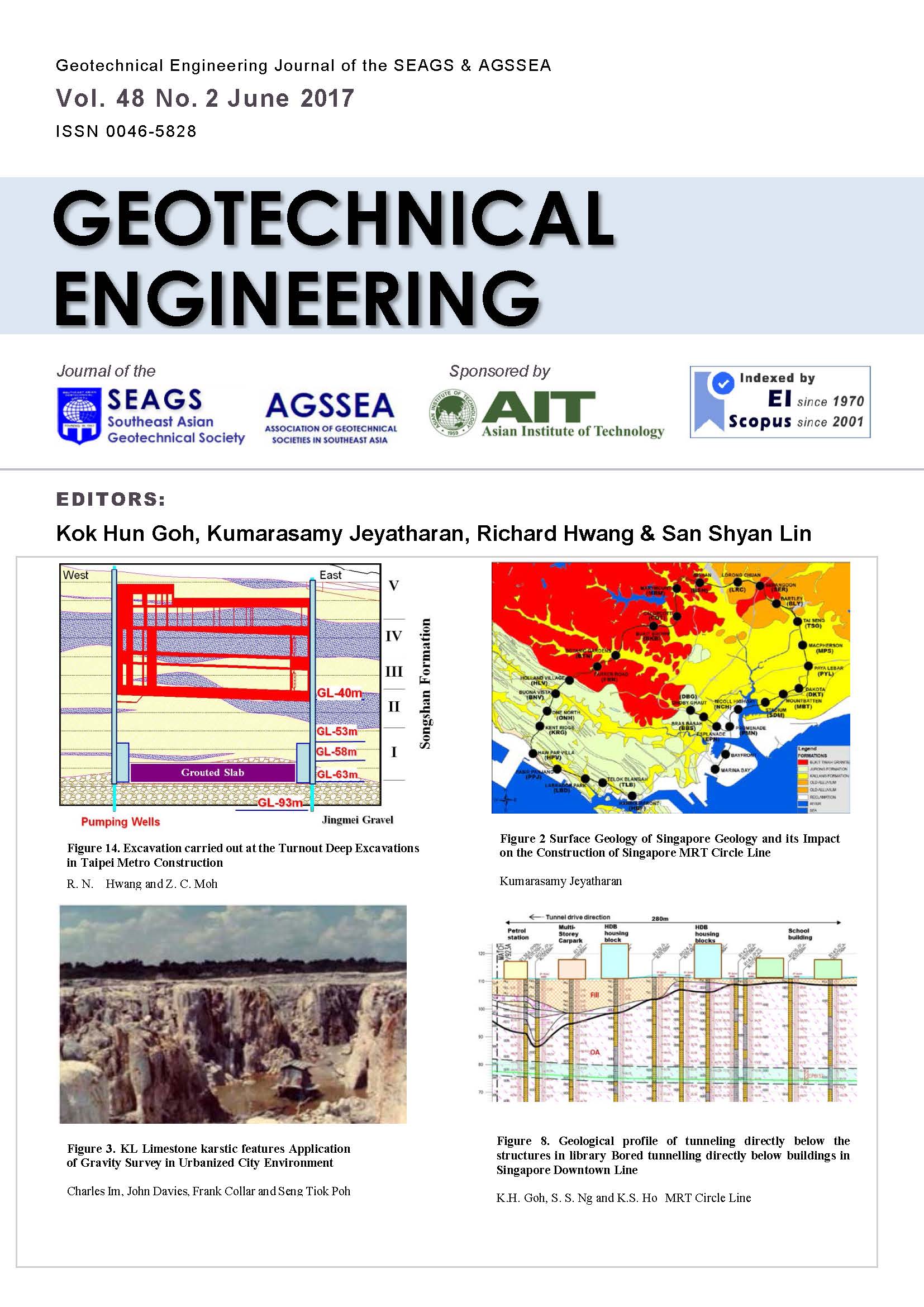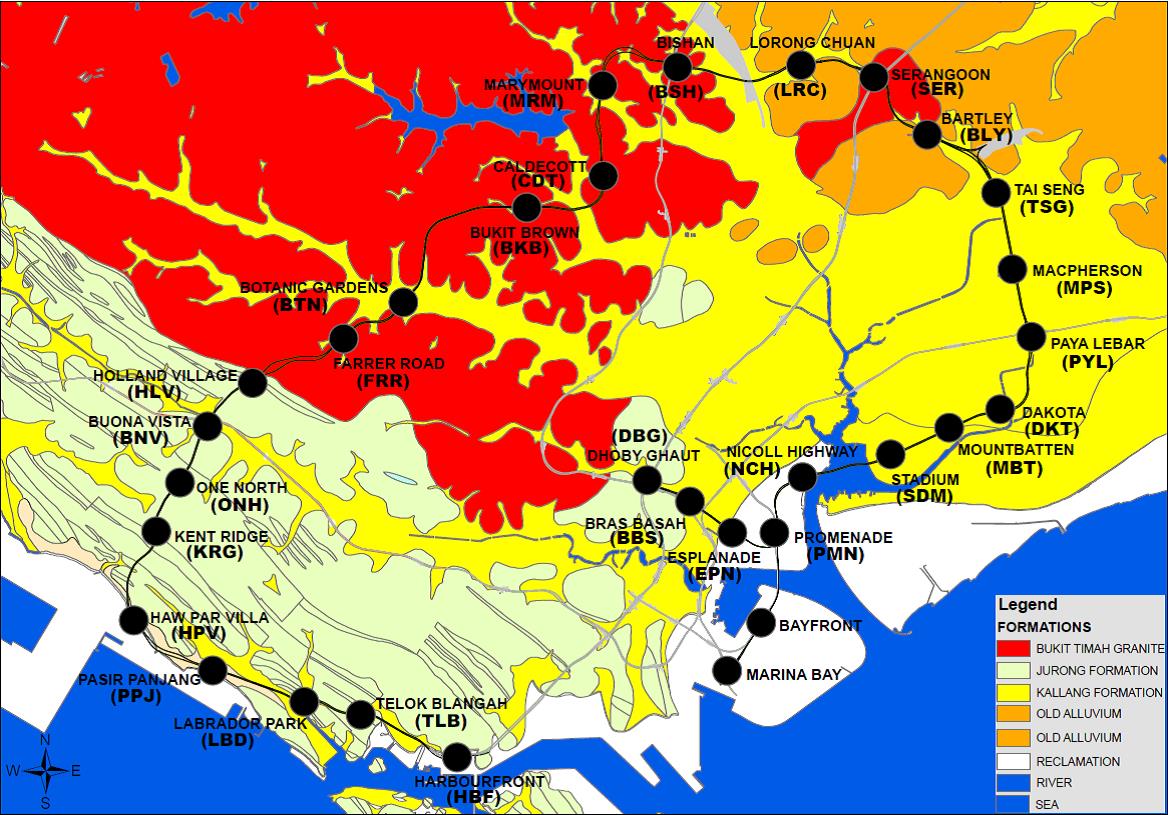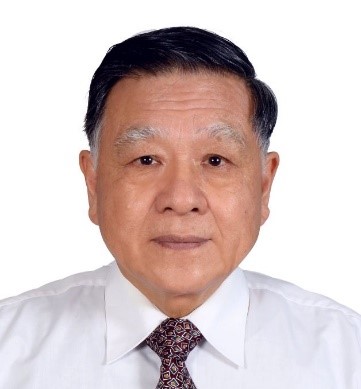

June 2017: Papers on Mass Transit Projects & also contributed papers
Edited by
Kok Hun Goh, Kumarasamy Jeyatharan, Richard Hwang & San Shyan Lin

Dr. Kok Hun Goh
Dr. Goh has 15 years of geotechnical engineering experience, and has been involved in the design aspects of various road and rail infrastructure projects in Singapore since 2001. He completed a doctoral study on the “Response of ground and buildings to deep excavations and tunnelling” in the University of Cambridge.

Dr. Kumaraswamy Jeyatharan
Jeyatharan received his Batchelor’s Degree from University of Peradeniya with First Class honours in 1985. His Ph D Degree is from Cambridge University on Centrifugal Model testing under Prof. Andrew Schofield. He worked for nearly five years with Parsons Brinckerhoff in Singapore Office. Since 2002 Jeyatharan is a Manger in the Land Transport Authority in Singapore working on many Major Projects.

Dr. Richard Hwang
Dr. Hwang received his bachelor degree from the National Taiwan University, master degree from North Dakota State University and doctor degree from the University of California at Berkeley. His doctoral research was on soil-structure interaction in earthquakes and he is one of the original authors of the finite element computer programmes FLUSH and QUAD4 for seismic studies. He was manager of Singapore Branch of Kiso-Jiban Consultants, and served as leader of a team of geotechnical engineers serving Singapore Mass Rapid Transit Corporation, which was later merged to Land Transport Authority, for the Phase 1 construction of the Singapore metro systems. At Moh and Associates, Inc. he led a team serving Department of Rapid Transit Systems providing geotechnical engineering consulting services on the construction of Taipei Metro.
Dr. Hwang is specialized in numerical analyses, foundation engineering, and underground constructions and has authored and co-authored 160 technical papers. He delivered the 7th Geotechnical Engineering Heritage Lecture at Taiwan Professional Engineers Association and received Geotechnical Engineering Heritage Award from Sino-Geotechnics Research and Development Foundation.

Prof. San Shyan Lin
Prof. Lin is a Professor at Department of Harbor and River Engineering of National Taiwan Ocean University in Taiwan. He received his Ph.D. degree in Civil Engineering from Washington University in St. Louis, Missouri USA in 1992. Dr. Lin was an engineer at Taiwan Area National Expressway Engineering Bureau from 1992 to 1994. Prof. Lin also served as TRB A2K03 Committee member on Foundations of Bridges and Other Structures between 1995 and 2004. He is also serving as committee member of TC-212 and ATC-1 of ISSMGE and as editorial board member of four major international journals in geotechnical engineering.
Prof. Lin’s research and practical experiences have been dealt with static and dynamic behaviour of deep foundations, ground improvement and effects of scouring on bridge foundations. In the past decades, he was involved in many research projects such as interpretation of pile load testing results due to axial, lateral, or combined loading; effect of soil liquefaction on performance of pile foundation in sand; seismic effect of pile foundations; performance of suction pile in sand or in clay; and effect of scouring on performance of pile and caisson foundations etc. Prof. Lin has published more than 110 peer-reviewed journal papers and conference papers. One of his published Journal papers dealing with cyclic lateral loading effect on permanent strain of deep foundation due to cyclic lateral loading has been cited more than 60 times in Google academic website by many international researchers working on wind turbine foundations.
Preface
There are 16 papers in this Issue; the first eleven are papers edited by the Guest Editors: Kok Hun Goh, Jeyatharan and Richard Hwang; additionally there are five contributed papers are processed by our in-house editors.
The first paper is by R. N. Hwang and Z. C. Moh on on Deep Excavations in Taipei Metro Construction: Discussed herein are the geological features of the Taipei Basin relevant to the construction of Taipei Metro and the deep excavations carried out with emphasis on back analyses of wall deflections. The excavation at the crossover next to G17 Station of the Green Line is adopted as an example to illustrate the applications of wall deflection paths and reference envelopes. The importance of calibrating inclinometer readings to account for the movements at the tips is confirmed by numerical analyses; and the assumption that movements at the joints between the struts at the first level and the diaphragm walls would be negligible in subsequent stages of excavation once these struts are preloaded is verified. Furthermore, it is proved that the concept of wall deflection path is very useful to quantify the influence of various factors, e.g., the depth and width of excavation, wall length, preloads of struts, and the thickness of soft deposits, on the performance of diaphragm walls.
The second paper is by darci wen on Development of Reinforced Concrete Segmental Lining Design for MRT Bored Tunnels in Singapore: Reinforced concrete segments are commonly used as tunnel linings for bored tunnels constructed by tunnel boring machines (TBM). They have been used from 1980s till today for the majority of the Singapore Mass Rapid Transit (MRT) bored tunnels constructed by TBM as permanent supports. This paper describes the development and evolution of the segmental lining design from the Phases I/II of the MRT construction in the 1980s to the current design for the MRT lines under construction. The topics include the general arrangement of the segmental linings, structural design requirements, durability requirements, fire resistance and selection of waterproofing materials of the linings. The design and construction of bored tunnels in close proximity is presented with the experience gained in the past projects. Fire tests conducted by the Land Transport Authority are also presented. The rational, experience and challenges of adopting steel fibre reinforced concrete segments in recent MRT projects are discussed in the paper. The paper also presents in detail the experience gained in Singapore MRT projects in selecting the gaskets for waterproofing of the joints between segments to achieve the durability requirements for the bored tunnels.
Kumarasamy Jeyatharan in the third paper describe Geology and its Impact on the Construction of Singapore MRT Circle Line:
The Circle Line (CCL) is a fully underground railway line in Singapore connecting the inner suburban areas of the city. It is 39.5 km long with 34 stations and built in six separate packages. Site investigations comprising boreholes, CPTs and geophysical surveys for the project were carried out in various phases to reveal ground conditions along the route and decide on the construction methods. Extensive field and laboratory testing were also carried out to establish geotechnical design parameters. This paper summarises geological conditions encountered along the CCL route and highlights the effect of geology on selected construction methods.
In their paper (fourth one) K.H. Goh and Y. Zhang, describe how to construct the cut-and-cover tunnels and bored tunnels of the Singapore Downtown Line: The Downtown Line (DTL) is a major MRT line under construction after the completion of the Circle Line in Singapore. This paper will review the ground conditions for the DTL and how the ground condition has influenced the decision on the selection of the support systems adopted for the excavation for the stations which are constructed using cut-and-cover method, and also the selection of tunnel boring machines for the bored tunnelling works. The key features of the temporary support systems will be presented in the paper and their performance will be reviewed in terms of ground movements and ground water table drawdown and its impacts. Issues encountered during the excavation, in particular for DTL Stage 2 in the soils and rocks of the Bukit Timah Granite Formation will be presented in the paper and the effectiveness of various measures implemented will be discussed based on the experience and observations during the construction. The key features and parameters of the TBM used in the projects will also be presented.
The fifth paper is on Bored tunnelling directly below buildings in Singapore Downtown Line by K.H Goh et al.: Other than basement construction of building complexes for parking and other functions, many cities in the world are also embarking on major construction projects to put roads, metro infrastructure, municipal services and utilities, under the ground. One of the specific challenges faced is the construction of bored tunnels directly below buildings. This paper reports the experiences of bored tunnelling directly below several buildings in the recently implemented Downtown Line project. These case studies would include details such as the structural system and foundation details of the buildings, ground condition, geometry and clearance between the building foundation and the tunnelling works, as well as instrumentation monitoring results of ground and building settlement during tunnelling. It is hoped that these cases could be used as references in the design of future bored tunnelling works, to give greater confidence that tunnelling directly below buildings can be carried out without affecting the buildings so long as appropriate tunnelling controls are taken to mitigate ground deformation issues.
Charles Im et al in their paper sixth in the series Application of Gravity Survey in Urbanized City Environment discuss subsurface information and geotechnical data are required during the planning, development and design stages of all construction projects particularly where major components are supported on or in the earth and underlying rock. An understanding of the basic site geology is also necessary for the proper planning of the ground investigation works. Consequently, the geological features that will affect the design and construction of the project must be investigated and evaluated as much as possible within the allowable project timeframe to ensure successful implementation of the project. This paper presents an overview of the authors’ experiences in using Gravity Survey, as a reconnaissance ground investigation method to identify areas of enhanced ground risks, in the complex variable and unpredictable Kuala Lumpur Karstic Limestone formation during the underground reference design stage of the Klang Valley Mass Rapid Transit Line 2 (SSP Line) in Kuala Lumpur, Malaysia. This paper also presents some lessons learnt of the past in the region, and what were the specific measures that had been strictly implemented on this occasion to ensure quality results can be derived from the Gravity Survey within the urbanized city environment and meet the objectives of the survey.
M. Kawasaki et al are the authors of the seventh paper on Water Sealing by Wire Brush with Grease for Pneumatic Caisson Method at Great Depth Underground : Pneumatic caisson method can be widely applied to various ground and has high reliability, while its applicable depth is limited due to the work under high atmospheric pressure. To overcome the problem, the pneumatic caisson method employing an unmanned excavation method with helium mixed gas has been developed, which enables the work under pressure up to 0.7 MPa. However, the new technology of the pneumatic caisson method will be required to construct a vertical shaft for urban tunnels at great depth underground space. Therefore, applying water-sealing technique at shield tail to friction cut space around pneumatic caisson wall, a method to reduce atmospheric pressure in a working chamber at the ground with low permeability has been proposed. This research carried out the element tests to examine the water-sealing performance of the proposed method, and discussed the influence of some properties on water-sealing performance and its mechanism. As a result, it was confirmed that the proposed method can keep the grease pressure of 1 MPa for one hour
The eighth paper by N. Som and is titled Geotechnical Challenges of Kolkata Metro Construction: The paper gives an account of the Kolkata Metro construction which included the first underground railway for mass rapid transit system of an Indian city. Construction was started in 1975 and the first line of the metro covering a length of 17 km was opened in 1984. Thereafter construction had been taken up in phases. Currently Kolkata metro construction includes an ambitious package of 140 km of underground, at grade and viaduct stretches. Construction has to be done in very difficult condition through congested urban areas which includes a tunnel below the Ganga river. Resource crunch and construction through heavily built-up urban land extended the period of construction but modern design techniques and field instrumentation have helped to ensure high quality work in densely populated urban centre.
In the subsequent paper nine in the series Gerardo Agustin Pittaro deal with the use of pressure relief wells to optimise ground improvement layer thickness in deep excavations: Deep excavations in soft ground often need stabilization with ground improvement (GI). One of the methods to improve the ground is to use Jet Grouting Piles (JGP) or Deep Soil Mixing (DSM). JGP and DSM are achieved by mixing the soil with cement and water, generating a structure that performs well under compression forces but not under tension forces. These ground improvement blocks provide larger passive resistance thereby reducing wall displacements. Due to the above mentioned one of the necessary requirements for successful design is that no tension forces are allowed in any zone of the ground improvement block. This paper discussed how pressure relief wells inside the excavation are used in order to decrease the tension strains in the ground improvement block. In order to demonstrate this, 2D numerical analyses were performed.
C. Veeresh and K.H. Goh in the tenth paper deal with Bukit Timah Granite Formation – Engineering Properties and Construction Challenges: The Bukit Timah Granite Formation is one of the oldest geological formations in Singapore and is found mostly in the central and northern parts of Singapore. A major section of Singapore’s underground metro construction passes through the Bukit Timah formation soils, and extensive field and laboratory testing has been carried out on the rock samples. Uniaxial Compressive Strength (UCS) tests have been carried out on hundreds of samples, test results have shown wide variation in the strength and the maximum strength is found to be much higher compared to the previously published data by Zhao et al 1995. This paper presents a review of UCS strength of the Bukit Timah Formation, Point Load index tests and correlations which were developed for site specific locations. This paper also reviews the abrasivity of Bukit Timah Granite and factors affecting it. Influence of UCS and other factors on the drilling, coring and excavation rates in Bukit Timah Granite are also presented.
L.J.Endicott is the eleventh paper and the last one as assembled by the guest editors deal experiences of 41 years of Mass Transit Underground Railways: In 1975 many cities in South East Asia were becoming congested and few had underground railways. Now several cities have underground railway systems comprising several lines and many stations, some extend above ground. Currently underground railways are being built or are being extended in many cities in South East Asia. Construction projects are often large including several sections of tunnels and stations in one contract. This paper reflects on the early days of pioneering and on some of the changes that have taken place in the planning, design, and construction of underground Mass Transit Systems during the last 41 years.
The 12th paper by describe by Badee Alshameri is the first of the contributed papers edited by San Shyan Lin on Comparison of the Effect of Fine Content and Density towards the Shear Strength Parameters: The improvement of soil strength is very important in the engineering design for the civil and geotechnical projects. However, this improvement can be achieved by improving the shear strength parameters of soil (i.e. shear strength, friction angle and cohesion) by using different techniques (e.g. densify the soil and change the soil composition). This paper will compare between the effects of density and fine content towards the shear strength parameters. Numerous soil samples (i.e. 99 samples) from six soil mixtures of sand-kaolin mixtures were compacted and subjected to direct shear box test to evaluate the effect of density and fine content. The results showed some discordant effects between the density and fine content. While the cohesion increased by the increment of the fine content, it decreased by the increment of the density. However, both of shear strength and friction angle increased to the highest value with the increment of the fine content and density then by further increment in the fine content and density, the shear strength and friction decreased where this behaviour can be explained through the inter-granular void ratio issue. On the other side, even the results showed interface between the effect of density and fine content, but the fine content has more significant effect in the shear strength parameters and also in the soil density value itself.
The 13th paper (also contributed direct to the in-house editors) by T. G. Santhoshkumar et al is on the Role of Bentonite in Improving the Efficiency of Cement Grouting in Coarse Sand: Grouting generally is used to fill the voids in the ground (fissures and porous structures) with the aim of increasing resistance against deformation, to increase cohesion, shear strength and uniaxial compressive strength or finally (even more frequently) to reduce conductivity and interconnected porosity in an aquifer. In the case of loose sandy soils, the very low bearing capacity of the foundation bed causes shear failure and excessive settlements. Cement grouting technique is one of the possible solutions to the foundation problems for improving the properties of soil at shallow depths. Various authors have recommended a number of additives that can be used in cement grouting. Admixtures like antibleeder increases viscosity of the cement grouts, at the same time reducing sedimentation to a considerable extent. Bentonite can be considered as a cheap and effective admixture for cement grouts with regard to stability. This paper presents the results of experimental studies conducted in the laboratory, in this direction. It was found that addition of small percentages of bentonite and detergent increases the lateral flow of cement grout in coarse sand. The results clearly indicate that addition of even a small amount of bentonite to the cement grout increases the grouting efficiency in coarse sand.
The 14th Paper (also contributed direct to the in-house editors) by Xiao-long Zhou et al is on Shaft Resistances of Jacked Open-ended PHC Pipe Piles: The shaft resistance of open-ended pipe piles during installation and static loading test plays an important role in the design of pile foundation. One open-ended Pre-stressed High-strength Concrete (PHC) instrumented with sensors was jacked to investigate the performance of shaft resistance during installation and loading test. Test results indicated that the shaft resistances gradually transferred along depth during installation, and the magnitude is closely related to soil properties. The shaft resistance at the same depth decrease with jacked cycles. After five jacked cycles, the shaft resistances in sand silt at 6 m depth decreased about 58.8%. The decrement of silty clay at 10 m depth was about 12.1% after three jacked cycles. In the loading test, the shaft resistance of test pile were gradually mobilized from up to down.
P.R. Stott and E. Theron in the 15th paper (also contributed direct to the in-house editors) is on the Estimation of Shrink/Swell Potential and Variability of Clays by Small-Scale Suction Tests: The relationship between suction and water content gives crucial information about a soil. Small projects like economic housing do not warrant the time and cost of determining the full soil water suction curve. A considerable range of soil suctions can easily be achieved within a reasonably short time by using small samples, simple suction control and a high precision balance. It appears that in this way it may be possible to estimate heave potential and variability of soil properties at reasonable cost in an acceptable time. Variability assessment appears to offer significant potential for improving the reliability of foundation design on shrink/swell soils.
The last paper of this Issue the 16th one ((also contributed direct to the in-house editors) by M. R. Selamat et al is on Pullout Tests on Strips with Anchorage Elements under Low Stresses: The lack of pullout capacity of reinforcement strips often compromised the finishing quality of the mechanically stabilized earth (MSE) structure. In this research, three strips were each attached with 6 anchorage elements of 1cm, 2cm, and 3cm deep respectively in order to enhance the pullout capacities, while another strip was plain. Each strip was subjected to pullout tests under low normal stresses ranging from 1.61kPa to 13.20kPa to simulate shallow embedment in the field. Under the low normal stress of 1.61kPa, the pullout capacities of strips with anchorage elements were enhanced up to 366% of the plain strip capacity; under the higher normal stress of 13.2kPa however, the pullout capacity enhancements were only up to 163% of the plain strip capacity. The results indicate the merit of attaching anchorage elements to strips under shallow overburden in a MSE structure and the significant increase in pullout capacity achievable by such strips.
Editors:
Kok Hun Goh
Kumarasamy Jeyatharan
Richard Hwang
San Shyan Lin
ACKNOWLEDGEMENT
Sixteen papers are contained in this issue. Eleven of them are assembled by the Guest Editors and another five contributed papers by the in-house edotors. No doubt the material contained herein would be most valuable to our profession. The editors have adequately described the contributions in the preface. They are to be congratulated for these contributions.
Dr. Teik Aun Ooi
Prof. San Shyan Lin
Prof. Kwet Yew Yong
Dr. Noppadol Phienwej
Prof. A. S. Balasubramaniam
Contents
- Deep Excavations in Taipei Metro Construction
R. N. Hwang and Z. C. Moh - Development of Reinforced Concrete Segmental Lining Design for MRT Bored Tunnels in Singapore
D Wen - Geology and its Impact on the Construction of Singapore MRT Circle Line
Kumarasamy Jeyatharan - Constructing the cut-and-cover tunnels and bored tunnels of the Singapore Downtown Line
K.H. Goh and Y. Zhang - Bored tunnelling directly below buildings in Singapore Downtown Line
K.H. Goh, S. S. Ng and K.S. Ho - Application of Gravity Survey in Urbanized City Environment
Charles Im, John Davies, Frank Collar and Seng Tiok Poh - Water Sealing by Wire Brush with Grease for Pneumatic Caisson Method at Great Depth Underground
M. Kawasaki, K. Yoshizaki and M. Sugimoto - Geotechnical Challenges of Kolkata Metro Construction
N. Som - Use of pressure relief wells to optimise ground improvement layer thickness in deep excavations
Gerardo Agustin Pittaro - Bukit Timah Granite Formation: Engineering Properties and Construction Challenges
C. Veeresh and K.H. Goh - 41 years of Mass Transit Underground Railways
L. J. Endicott - Comparison of the Effect of Fine Content and Density towards the Shear Strength Parameters
Badee Alshameri - Role of Bentonite in Improving the Efficiency of Cement Grouting in Coarse Sand
T. G. Santhoshkumar, B. M. Abraham, A. Sridharan, and B. T. Jose - Shaft Resistances of Jacked Open-ended PHC Pipe Piles
Xiao-long Zhou, Hai-lei Kou, Chang-hong Li - Estimation of Shrink/Swell Potential and Variability of Clays by Small-Scale Suction Tests
P.R. Stott and E. Theron - Pullout Tests on Strips with Anchorage Elements under Low Stresses
M. R. Selamat, M. H. Roslan, and M. A. M. Ismail




































